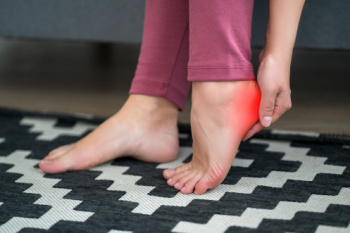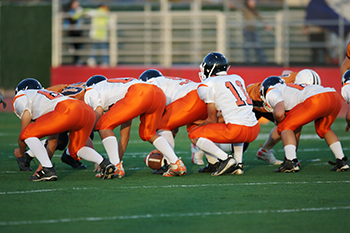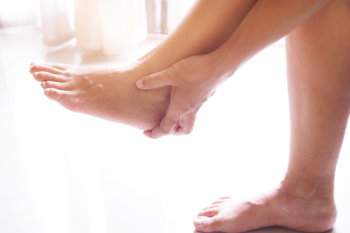Langley (604)-530-1561
Fax (778)-278-1561
Email podiatry@urton.ca
March 2024
Conditions Associated With Heel Spurs
 Heel spurs are bony growths that develop on the underside of the heel bone, often near the point where the plantar fascia connects to the bone. While they can be asymptomatic, heel spurs are frequently associated with certain foot conditions, serving as indicators of underlying issues. Primarily, they're linked with plantar fasciitis, a condition where the ligament running along the bottom of your foot becomes inflamed and causes heel pain. This inflammation can lead to the development of a spur. Heel spurs are also frequently associated with chronic conditions stemming from strain on the foot muscles and ligaments, or from repeated tearing of the membrane that covers the heel bone. Such strain and tearing can be due to excessive weight, poor shoe choices, or an active lifestyle without adequate foot support. The association of heel spurs with other conditions typically means there will be a comprehensive approach to treatment, which may include stretches, orthotic support, or lifestyle modifications to address the root cause of the pain. If you are suffering from a heel spur, it is suggested you make an appointment with a podiatrist who can diagnose the underlying problem and help you find relief.
Heel spurs are bony growths that develop on the underside of the heel bone, often near the point where the plantar fascia connects to the bone. While they can be asymptomatic, heel spurs are frequently associated with certain foot conditions, serving as indicators of underlying issues. Primarily, they're linked with plantar fasciitis, a condition where the ligament running along the bottom of your foot becomes inflamed and causes heel pain. This inflammation can lead to the development of a spur. Heel spurs are also frequently associated with chronic conditions stemming from strain on the foot muscles and ligaments, or from repeated tearing of the membrane that covers the heel bone. Such strain and tearing can be due to excessive weight, poor shoe choices, or an active lifestyle without adequate foot support. The association of heel spurs with other conditions typically means there will be a comprehensive approach to treatment, which may include stretches, orthotic support, or lifestyle modifications to address the root cause of the pain. If you are suffering from a heel spur, it is suggested you make an appointment with a podiatrist who can diagnose the underlying problem and help you find relief.
Heel spurs can be incredibly painful and sometimes may make you unable to participate in physical activities. To get medical care for your heel spurs, contact William Urton, DPM from British Columbia. Our doctor will do everything possible to treat your condition.
Heels Spurs
Heel spurs are formed by calcium deposits on the back of the foot where the heel is. This can also be caused by small fragments of bone breaking off one section of the foot, attaching onto the back of the foot. Heel spurs can also be bone growth on the back of the foot and may grow in the direction of the arch of the foot.
Older individuals usually suffer from heel spurs and pain sometimes intensifies with age. One of the main condition's spurs are related to is plantar fasciitis.
Pain
The pain associated with spurs is often because of weight placed on the feet. When someone is walking, their entire weight is concentrated on the feet. Bone spurs then have the tendency to affect other bones and tissues around the foot. As the pain continues, the feet will become tender and sensitive over time.
Treatments
There are many ways to treat heel spurs. If one is suffering from heel spurs in conjunction with pain, there are several methods for healing. Medication, surgery, and herbal care are some options.
If you have any questions feel free to contact our office located in Langley, BC . We offer the latest in diagnostic and treatment technology to meet your needs.
Symptoms of Turf Toe

Turf toe, a common injury among athletes, occurs when the ligaments surrounding the big toe joint are sprained due to forceful pushing during activities like running or jumping. Turf toe injuries typically happen during sports practice, and are common in football and soccer. An early sign of turf toe is foot pain, which often intensifies with movement. This discomfort may lead to limping or difficulty in walking, occasionally rendering you immobile for a brief period. Sometimes a popping sound in the joint may indicate turf toe. Severe cases may necessitate immobilization or even surgery. It is extremely important not to ignore symptoms of turf toe, as early intervention can accelerate recovery and prevent long-term complications. If you are experiencing persistent pain or limited mobility in your big toe joint, it is suggested that you schedule an appointment with a podiatrist for a diagnosis. This medically trained foot doctor can perform imaging tests, a physical examination, and develop a treatment plan to address your specific needs.
Toe pain can disrupt your daily activities. If you have any concerns, contact William Urton, DPM of British Columbia. Our doctor can provide the care you need to keep you pain-free and on your feet.
What Causes Toe Pain?
Most severe toe pain is caused due to a sports injury, trauma from dropping something heavy on the toe, or bumping into something rigid. Other problems can develop over time for various reasons.
Toe pain can be caused by one or more ailments. The most common include:
- Trauma
- Sports injury
- Wearing shoes that are too tight
- Arthritis
- Gout
- Corns and calluses
- Hammertoe
- Bunions
- Blisters
- Ingrown toenails
- Sprains
- Fractures (broken bones)
- Dislocations
When to See a Podiatrist
- Severe pain
- Persistent pain that lasts more than a week
- Signs of infection
- Continued swelling
- Pain that prevents walking
Diagnosis
In many cases the cause of toe pain is obvious, but in others, a podiatrist may want to use more advanced methods to determine the problem. These can range from simple visual inspections and sensation tests to X-rays and MRI scans. Prior medical history, family medical history, and any recent physical traumatic events will all be taken into consideration for a proper diagnosis.
Treatment
Treatments for toe pain and injuries vary and may include shoe inserts, padding, taping, medicines, injections, and in some cases, surgery. If you believe that you have broken a toe, please see a podiatrist as soon as possible.
If you have any questions please feel free to contact our office located in Langley, BC . We offer the newest diagnostic tools and technology to treat your foot and ankle needs.
Children’s Footwear

Proper footwear is important for your child's general foot health. Children's foot bones are soft cartilage in the first few years of life, so they need space to grow naturally. Ignoring foot health can also lead to leg and back problems later in life. Going barefoot sometimes can help with natural development, shoes are necessary for warmth, protection, and support. When buying shoes, measure your child's feet regularly and ensure there's enough room for their feet to grow. Ignore marked shoe sizes and focus on inner length measurements, which is the measurement of the inside of the shoe from the toe to heel. It is normal for shoes to look big on toddlers, as their feet grow rapidly. Look for shoes that are foot-shaped, breathable, flexible, and have a back, regardless of the season. Remember, every pair of shoes is important in shaping your child's foot health for life. If you are a parent and want to ensure that your child’s footwear is best for their foot health, it is suggested that you take your child to a podiatrist for an exam, proper foot measurement, and discussion of what type of shoes would best suit your child’s feet for healthy growth.
The health of a child’s feet is vital to their overall well-being. If you have any questions regarding foot health, contact William Urton, DPM of British Columbia. Our doctor can provide the care you need to keep you pain-free and on your feet.
Tips for Keeping Children's Feet Healthy
- Make sure their shoes fit properly
- Look for any signs of in-toeing or out-toeing
- Check to see if they have Clubfoot (condition that affects your child’s foot and ankle, twisting the heel and toes inward) which is one of the most common nonmajor birth defects.
- Lightly cover your baby’s feet (Tight covers may keep your baby from moving their feet freely, and could prevent normal development)
- Allow your toddler to go shoeless (Shoes can be restricting for a young child’s foot)
- Cut toenails straight across to avoid ingrown toenails
- Keep your child’s foot clean and dry
- Cover cuts and scrapes. Wash any scratches with soap and water and cover them with a bandage until they’ve healed.
If you have any questions, please feel free to contact our office located in Langley, BC . We offer the newest diagnostic and treatment technologies for all your foot care needs.
Causes and Treatments for Plantar Fasciitis

Heel pain is often caused by plantar fasciitis, which is an inflammation of the fascia running along the sole of the foot. Diagnosis of plantar fasciitis relies on symptoms such as morning pain and can be exacerbated by factors like obesity, flat feet, or excessive standing on hard surfaces. There are various relief techniques that affected individuals can take advantage of, and a podiatrist can guide you toward the methods that are best for you. If you have chronic heel pain, it is suggested that you schedule an appointment with this type of doctor who can perform an accurate diagnosis and get you the right treatment.
Many people suffer from bouts of heel pain. For more information, contact William Urton, DPM of British Columbia. Our doctor can provide the care you need to keep you pain-free and on your feet.
Causes of Heel Pain
Heel pain is often associated with plantar fasciitis. The plantar fascia is a band of tissues that extends along the bottom of the foot. A rip or tear in this ligament can cause inflammation of the tissue.
Achilles tendonitis is another cause of heel pain. Inflammation of the Achilles tendon will cause pain from fractures and muscle tearing. Lack of flexibility is also another symptom.
Heel spurs are another cause of pain. When the tissues of the plantar fascia undergo a great deal of stress, it can lead to ligament separation from the heel bone, causing heel spurs.
Why Might Heel Pain Occur?
- Wearing ill-fitting shoes
- Wearing non-supportive shoes
- Weight change
- Excessive running
Treatments
Heel pain should be treated as soon as possible for immediate results. Keeping your feet in a stress-free environment will help. If you suffer from Achilles tendonitis or plantar fasciitis, applying ice will reduce the swelling. Stretching before an exercise like running will help the muscles. Using all these tips will help make heel pain a condition of the past.
If you have any questions please contact our office located in Langley, BC . We offer the newest diagnostic and treatment technologies for all your foot and ankle needs.








